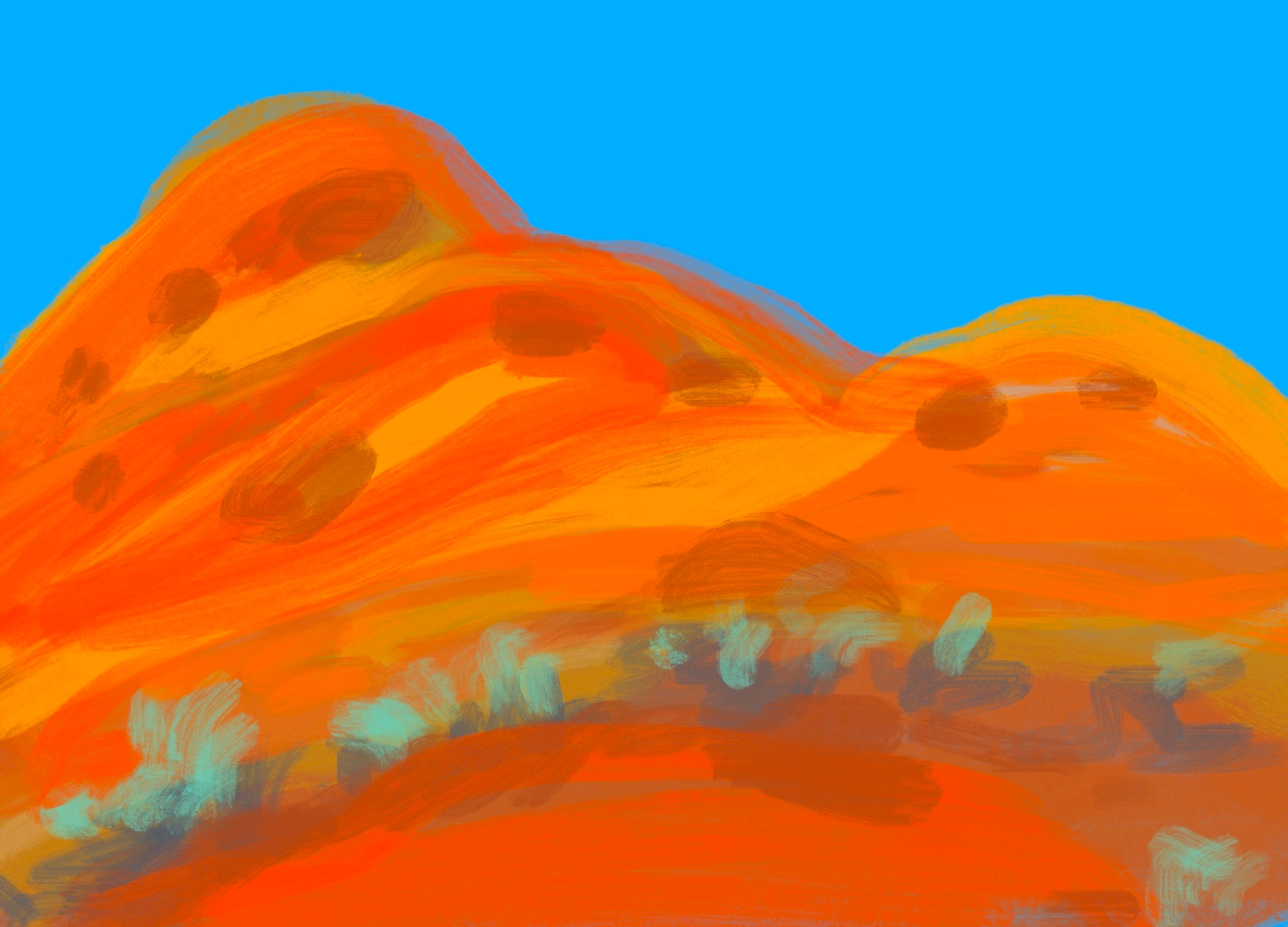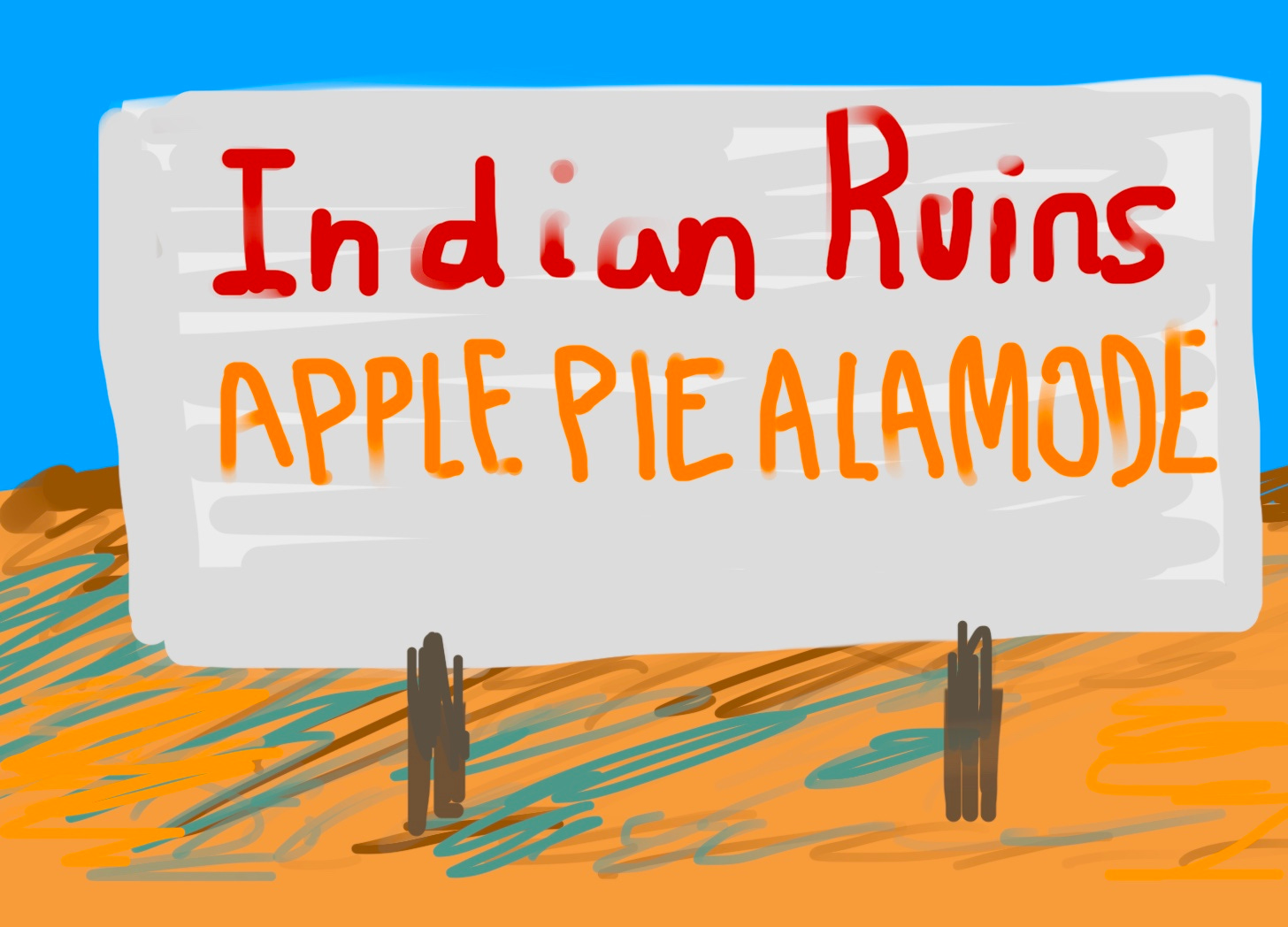America, the beautiful
Thoughts on colonialism, Dean Kissick and identity issues prompted by a road trip across the Southwest
I am driving across the southwest from Los Angeles to New Mexico, where I’ve never been before. It is so gorgeous. I can’t take my eyes off the amazing views. I’m recording this as a voice-to-text and I’m passing signs for the painted desert.
I have listened to a lot of early U2, Joshua Tree being the obvious choice as I drove through and past Joshua Tree, CA. The soaring vocals and crunchy guitar are a perfect accompaniment for desolate highways.
On my way to New Mexico, I stopped near Las Vegas and did a hike with fellow Gutsy Radio DJ, Brian Nealon. We went to the Valley of Fire which deserves its own essay for the name alone. Being in places like this, my little Midwestern brain doesn’t know how to compute. The giant striated rocks have been painted by time in a palette of gold, red, and burgundy. After walking in the red sand for a while, the gray chaparral began to vibrate blue and mint green. Some of the rocks reminded us of The Beatle’s Yellow Submarine in cartoon form with its portal windows and pneumatic curves. You get why people go to the desert to take acid.
I’ve done a westward-bound road trip from LA to Phoenix before, but the land between Phoenix and New Mexico is new to me. West of Phoenix you pass a number of Indian reservations with tourist attractions that feature Indigenous artifacts, and history, but mostly shopping. For one, a destination with an exit called Indian Ruins, a reference to the Homolovi Ruins State Park I later found out, there is a series of billboards that broke my heart.
They featured items you could buy at Indian Ruins, a place I had trouble imagining as I passed each dystopian haiku:
Indian Ruins
ESPRESSO * LATTE
Indian Ruins
APPLE PIE A LA MODE
Indian Ruins
GIFTS * Carefully Wrapped
Indian Ruins
BOOKS ABOUT THE SOUTHWEST
Curators of America, let’s put the person who created these billboards in the next Whitney Biennial.
It’s impossible that the person or people creating those signs could not have seen the bigger message. Or was it just an accidental juxtaposition as happens sometimes in advertising - the way that Amazon’s arrow logo looks like a dick. Perhaps they intended it as a gaslighting jab at colonization. As with Amazon, we will never know their true intention. And at the same, these billboards are catchy. Who doesn’t want apple pie à la mode in the middle of the desert? I hope they make a ton of money.
At another stop I made along the way there were a couple of vendors with stores selling crystals, and petrified wood excavated from the surrounding lands. The people running the stores were Indigenous, as were the owners who are some of the only people with the right to pull petrified wood from the earth and sell it.
I stopped and looked with fascination like you’re supposed to, but when I left, I felt really bad. I had gotten a free half-pound little chunk of petrified wood because I brought in a coupon that entitled me to it. But the thought of mining these special artifacts that took millions of years to ripen and transform, and then to sell them or even give them away for nothing, hurt my heart. It was an extension of the chipping away of history that we will never get back from the early days of westward expansion.
When I first recorded these thoughts while driving, I was overcome with grief, tears streaming down my face. I have no idea why it hit me so hard just then - it could have been the exhaustion of long days on the road and low blood sugar. Or perhaps because I have been on my own journey to find belonging and am familiar with the sensation of rootlessness, the American Indigenous history of dislocation hits me in a soft spot.
Since seeing the toll that colonization has taken with my own eyes, I find the work of Jeffrey Gibson, an American Mississippi Choctaw/Cherokee, more important than ever. He has not only celebrated his Indigenous culture through his own work that fuses queer club culture and Indigenous iconography to create something new, but has also lifted others up with his new book, An Indigenous Present, that features 60+ Indigenous artists.

This past fall, in Dean Kissick’s much-debated Harper’s article about how DEI doesn’t belong in the art world, he name-checked Gibson as one of the artists he sees as succeeding unfairly because of the trend of making BIPOC artists so hot right now. Gibson is the first Indigenous American to show at the Venice Biennale’s American Pavilion and has been on a steady upward rise since I met him at CCA in grad school (I’m not worthy!, Wayne’s World-style).
As Ajay Kurian’s rebuttal in Cultured Mag, Make Art Great Again, pointed out, much of Kissick’s narrow and poorly maintained argument is white-favoring and nostalgic for a sort of art world Camelot. He directs his praise towards the Viennese Actionists who he says weren’t making work about politics and it was awesome, bro.
In reference to the Actionists’ performances with Das Orgien Mysterien Theater he writes “the participants were naked, wrapped in white sheets, soaked in the blood of cows they had sacrificed, performing rituals in their commune in the Austrian countryside, accompanied by music, singing, dancing, and feasting.” He then goes on to say, “[they] had nothing to do with personal identity or the imparting of information.”
Unfortunately bra, they were responding to life in a post-WWII Europe, and acting out against social norms of the time. In 1968, at the same time youthful protests against the status quo were breaking out across the world, Brus and Mühl of the Actionists issued a statement at the Art and Revolution event in Vienna that said, “‘Art’ is politics that has created new styles of communication.” So sadly, their work was not just about naked people splashing around in paint for kicks, although I’m sure it was also fun.
Also, you can’t separate the identity of the artists from work like this, and shouldn’t. The fact that they were Viennese is as significant to the meaning of their work as Gibson being an Indigenous American artist. (Also sorry not sorry for the Wikipedia source above, but that’s how easy it was to disprove his point.)
So back to the artists Kissick accuses of DEI-related inclusion in the canon. To stick with Gibson as an example, it’s incontrovertible that his works are significant and that he acts as a vehicle for the Indigenous voices, and especially queer Indigenous voices, that may not have a chance to speak for themselves.
As a newly trans person looking for trans-masc representation in the world, I can affirm from personal experience that representation is important in showing people what is possible.
While my essay is quite late to the rebuttal party, I would be curious to read an extended critique of the work he that he so loathed so much in the Barbican show, Unravel: The Power and Politics of Textiles in Art, and also why it is he conflated it with an accident in which his mother lost her limbs trying to see it. I am very sorry to both him and his mother for that, sincerely. Also, to judge a show by whether it would be worthy of losing limbs for would leave us with zero art worth seeing.
The art he critiques in the essay includes a collage of a “cheerful looking black woman,” and “small realist embroideries of drag and dyke marches.” What he didn’t say was why specifically, piece-by-piece, the work offended him so.
No one wants to be given opportunities because of tokenism, and certainly not to be called out for their identity the way women might be accused of sleeping their way to the top. People want to be celebrated because they have something to say and they say it well.
If we are going to call out artists as being diversity hires, as if we were talking about corporate America or college admissions, then we are going to miss out on the best that art and Art has to offer. Art can offer new perspectives and new stories that open the minds and hearts of otherwise disinterested people. It can make a case for the blending of old and new, and offer reasons for celebrating the overlooked. But to get the message you have to ask why, and be curious. (Or just research the show before you go and avoid shows you don’t like.)
If we are going to call out artists as being diversity hires, as if we were talking about corporate America or college admissions, then we are going to miss out on the best that art and Art has to offer. Art can offer new perspectives and new stories that open the minds and hearts of otherwise disinterested people.
I have always thought that the art world and the art market are like a big corporation, only without an HR department or any labor laws or minimum wage. It is 100% self-policed and community-moderated. It has never been fair. Nor is it immune from trends, or politics, or cults of personality. I just hope that as we move into MAGAland here in the US, and increased conservativism everywhere else, we can hold onto a desire for expansion and revolution at all costs. (Except for maybe loss of limbs. Pro peace over here.)
In the spirit of this essay, I’m sharing an interview I did with Indigenous American filmmaker Roberto Fatal where among other things, he shares his view on the ridiculousness white-centered sci-fi apocalypse movies. It’s hilarious and insightful.
If you would like to contribute to this work, consider joining my Patreon page: https://www.patreon.com/thesidewoo






loved this one, learned so much. thank you!